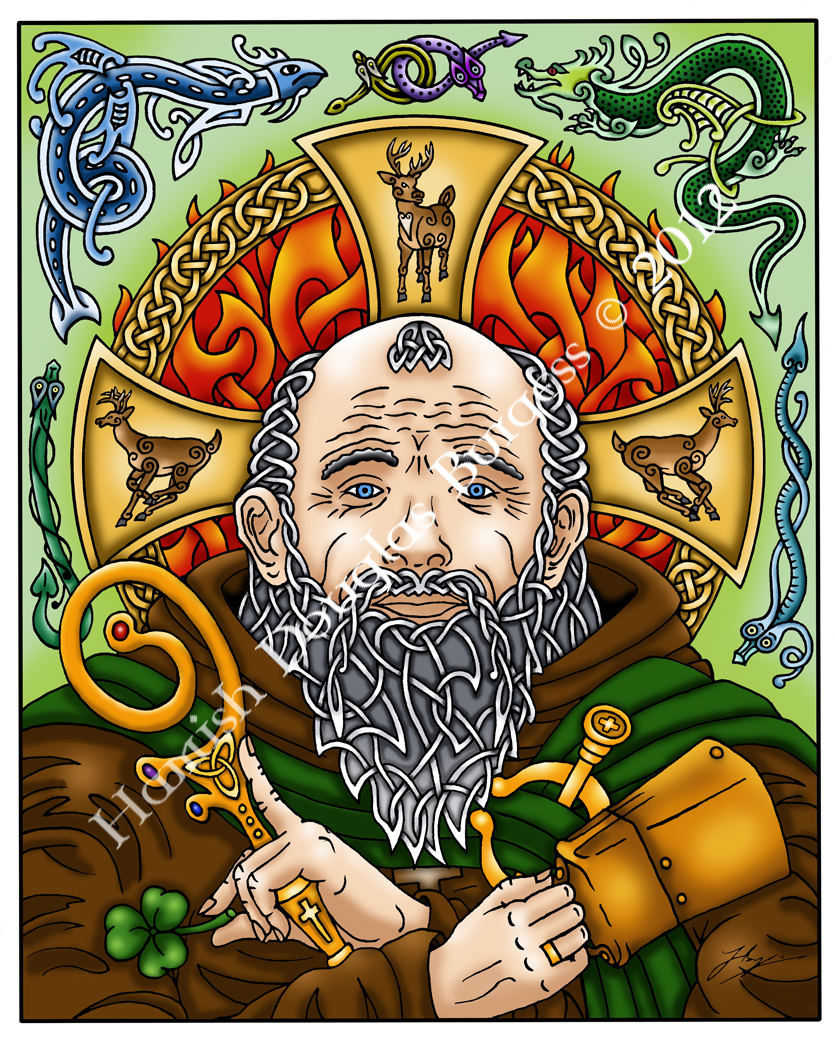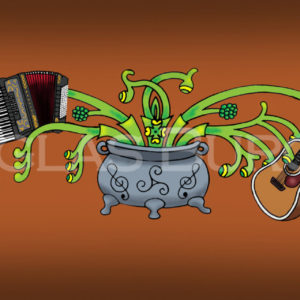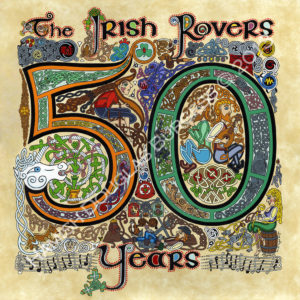St. Patrick
$150.00
ST. PATRICK © Hamish Burgess 2012. Signed and numbered Limited Edition Giclée print of 300 on water-colour paper.
11 x 14 inches, plus a white unprinted border.
- Handmade item
- Materials: Giclée, Print, Watercolor Paper
Please check back again shortly.
ST. PATRICK © Hamish Burgess 2012.
Signed and numbered Limited Edition Giclée print of 300 on water-colour paper. 11 x 14 inches, plus a white unprinted border.
Original Celtic and folk art by Hamish Burgess, a piece for the cover of The Celtic Connection newspaper in Vancouver BC and Seattle, the March issue.
The art shows St.Patrick in later life wearing clerical robes, with his famous bell in one hand, and his treasured staff or crozier and a shamrock in the other. He is depicted with a clerical tonsure, or shaved head, possibly referred to by his opponents the druids, who prophesied his converting the pagan folk of Ireland: “Across the sea will come Adze-head, crazed in the head, his cloak with hole for the head, his stick bent in the head. He will chant impieties from a table in the front of his house; all his people will answer: “so be it, so be it.“”
Behind him is the Paschal fire he lit to challenge the High King of Ireland, and the cross represents an invisible circle of divine protection, that he invoked with a chant which is now called “St.Patrick’s Breastplate”. It changed his own party into deer to escape the pagan warriors, and became known as “The Deer’s Cry”.
In the air around him are the ‘serpents’ of Ireland, in tradition likely referring to paganism, and two dragon-like creatures he is said to have cast down, the Caoránach, and the Oilliphéist. Read on for details……
Saint Patrick is the most famous of the saints, celebrated the world over on March 17th as the patron saint of Ireland, but most information about him is open to speculation. The ancient traditions surrounding him, most taken from accounts of his life written many years after his death, are disputed by scholars. Even his birth and death dates vary in different sources. St.Patrick himself left two written texts, the ‘Epistle to Coroticus’, and the ‘Confessio’ containing an account of his own life, in the ‘Book of Armagh’ now in Trinity College Library in Dublin.
St. Patrick was born around 387-390 AD with the Celtic name Maewyn Succat, in a village called Bannavem Taburniæ in Western Britain, either Wales or Scotland, under Roman rule. His parents were Calpurnius (a deacon, son of Potitus, a priest), and Conchessa. He adopted the title Patricius, or Patrick, upon becoming a priest. He died at Saul, Downpatrick Ireland, on the 17th of March 460 or some say 492. All dates are the subject of some debate.
At the age of 16 he was kidnapped by Irish pirates under Niall of the Nine Hostages, and brought to pagan Ireland. Sold as a slave to Meliuc, a landowner in Antrim, he tended sheep on Slemish Mountain for six years. During this time he learnt to speak Irish and exposed to druidism, as his master was a druid high priest, but found solace in his Christian faith. In a dream a voice told him to escape, and he traveled south for 200 miles and found a ship leaving for Gaul. After landing on 28 day journey with his starving pagan shipmates, he was taunted to use his faith to find them food, and upon praying, a herd of pigs appeared – one of his first religious experiences helping to convert his companions.
He trained as a cleric in France, in monasteries at Tours and Lerins, and was ordained a priest by St. Germain, bishop of Auxerre, then sent to teach Christianity to the Irish. He was to assist Palladius, already there on a mission, but he died and Patrick was ordained bishop himself in 432.
According to the ‘Annals of Ulster’ he landed in Ireland at Strangford Lough, and his first convert under Dichiu gave him land at Saul, and a building for a church. He spent time on his mission at the Ulster capital of Emain Macha and Ard Macha (Armagh), at the court of King Daire.
Murchiú’s ‘Life of Saint Patrick’ (‘Vita sancti Patricii’), one of the first accounts of the fifth-century saint, contains a supposed prophecy by druids showing how Patrick was seen by his opponents at the time:
“Across the sea will come Adze-head, crazed in the head,
his cloak with hole for the head, his stick bent in the head.
He will chant impieties from a table in the front of his house;
all his people will answer: “so be it, so be it.”‘
Patrick knew that he would have to convert King Laoghaire, the High King of Tara, to take his message around pagan Ireland. On the traditional start of spring all fires in Ireland were extinguished, to be ceremoniously lit from sacred druid fires. In legend, the night before Easter on March 25th 433, Patrick built a Paschal fire on the Hill of Slane, visible in the darkness from the Kings hall, which was strictly forbidden. King Laoghaire was infuriated and rode with his men to see who had challenged him.
According to tradition, he was challenged by the druid Lochru who abused his faith, and Patrick called upon divine retribution – Lochru was raised to a great height and dashed on the rocks below smashing his skull ! Patrick summoned heavy darkness and earthquakes, dispersing King Laoghaire’s host, leaving him with only 7 followers. He then incanted a lorica – a ‘Caim’ or chant to invoke an invisible circle of divine protection, which is now called “St.Patrick’s Breastplate”. It changed his own party into deer to escape the pagan warriors, and became known as “The Deer’s Cry”.
The next day Patrick went to the court of King Laoghaire, and was challenged to various trials of power by the druid Lucetmael. In the final one, a hut was to be burnt, built with one half dry wood, and the other new green wood. The druid stood on the wet side wearing Patrick’s cloak, and a young follower of Patrick wore the druids cloak on the dry side. The hut was burnt, and miraculously the boy survived unscathed with the druid’s cloak destroyed – but the druid died, with Patrick’s cloak remaining intact ! This convinced many of the people of the power of the new Christian faith, although the king refused to convert, he allowed Patrick the freedom to preach his message.
Folktales say that Patrick used the shamrock with three leaves to explain the Trinity – the Father, the Son and the Holy Spirit. An easy conversion for people used to triple goddesses. In a comparatively short 30 years Patrick managed to convert much of Ireland to Christianity, and effectively destroy paganism.
Irish legends say Patrick dealt with two monsters. The eel-like lake dwelling Caoránach, was said to be the mother of demons and devils, and was banished by Patrick to Lough Derg, or Red Lake, so called after the dragon’s blood. The dragon-like Oilliphéist heard that Patrick had come to drive out it’s kind, and in a rage fled Ireland slamming it’s tail on the land and cutting the route of the River Shannon !
It is said that St. Patrick drove the snakes from Ireland, most likely a reference to paganism. On March 17th every year, thousands of pilgrims climb 2,500 feet to the top of Croagh Patrick in pilgrimage. According to legend, at lent one year Patrick was fasting on the mountain (originally called Cruachan Aigli, or Hill of the Eagles) near Westport, Co Mayo. He was attacked by a horde of demons and serpents, rang his holy bell to turn them away, and had to throw it at them in order to make them flee, banishing them to Log na Deamhan, the Hollow of the Demons.
The bell, with it’s elaborate bell shrine container of gold and silver, is now in the National Museum of Ireland in Dublin. The ancient simple bell is made of iron coated in bronze, and according to the ’Annals of Ulster’ is first mentioned in the Book of Cuanu in the year 552. The bell ‘Clogh Dubh Phadraig’ was one of the three ‘relics of Patrick’ taken from his tomb sixty years after his death by Colum Cille, to be used as religious relics. The others were Patrick’s goblet and an ancient book, “The Angels Gospel“.
St.Patrick’s Crozier, ‘An Bachall Iosa’ (The Staff of Jesus), was made of wood, and supposedly handed to him by Jesus on an island in the Mediterranean, before he began his mission in Ireland. The ancient books ‘The Annals of Ulster’ and ‘The Four Masters’ both say that it was a symbol of Patrick’s authority. Patrick held the staff in such high esteem that he had an elaborate casing made for it by his companion the goldsmith Assicus, or St.Tussach. Described by St. Bernard of Clairvaux it was ‘covered with gold and adorned with the most costly gems’. As a national relic, oaths and treaties were signed on it, and it survived storms and invasions. It was tragically destroyed during Henry VIII’s Reformation in the 1500s, burnt in front of Christchurch Cathedral in Dublin.
All prints signed and numbered by the artist in pencil at the bottom.
The print you receive will not have the artist’s name across it, as in the photo. That is for internet viewing only.
Aloha and mahalo for looking.
| Dimensions | 11 × 14 in |
|---|







